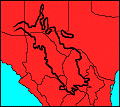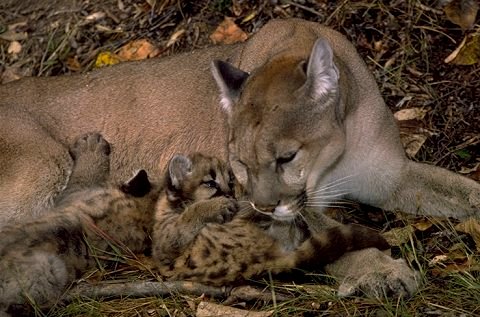


Puma concolor. Photographer: Gerald and Buff Corsi; Date of photo: Sep 1992; Location: Kalispell, MT. Copyright © 1999 California Academy of Sciences.
The Mountain Lion is given as Felis concolor in much of the literature.
Active both day and night in their territory, these large cats avoid man and wolves (their only predators) as much as possible (Boitani and Bartoli 1983). They are blamed often for the death of livestock and as such are considered unwanted predators around many ranchlands (Davis and Schmidly 1994).
Adult males average 2.3 m in total length, including a long tail measuring about 925 mm, and weigh 160-227 kg. Females average about 2.0 m and weigh 105-133 kg (Davis and Schmidly 1994). They are large, unspotted cats with lithe bodies and black-tipped tails. These cats are equipped with sharp, curved claws and small, round ears. Yellow-brown fur covers the body, with pale-colored hair along the underside (Cockrum 1982).
Puma concolor formerly occurred in all habitats within their range, but are now restricted to thinly populated, mountainous areas, often leaping to rocks and ledges to escape danger (Cockrum 1982). When pursued, they are also capable of climbing trees but prefer canyons, escarpments, or dense brush for dwellings. Contrary to popular belief, Mountain Lions rarely use caves as dens (Davis and Schmidly 1994).
The range of this species was throughout South and Central America and north into the United States and southern to central western Canada (Burt 1980). It has been eliminated in many areas of the eastern United States.
The diet of the Mountain Lion consists primarily of deer. However, it also can include smaller mammals (rabbits, rodents, etc.) (Davis and Schmidly 1994).
A short breeding period of up to 2 weeks leads to a gestation time of 90 days in which two to three (occasionally up to six) young are produced. These become independent after about 2 years (Boitani and Bartoli 1983). The young are spotted and weigh about 450 g each. Teeth develop at 1 month of age, and the young are weaned at 2-3 months (Davis and Schmidly 1994).
Boitani, L., and Bartoli, S. 1983. Simon and Schuster's Guide to Mammals. Simon and Schuster, New York, 511 pp.
Burt, W. H. 1980. Peterson Field Guides: Mammals. Houghton Mifflin Company, Boston, 289 pp.
Cockrum, E. L. 1982. Mammals of the Southwest. University of Arizona Press, Tucson, 176 pp.
Davis, W. B., and Schmidly, D. J. 1994. The Mammals of Texas. Texas Parks and Wildlife Press, Austin, 338 pp.
Todd Spurgeon, September 1997.
Last Update: 25 Jul 2009